To fully enjoy the world's 10 top cave dives, you'll need specialized training along with a good dose of caution and a strong sense of adventure. Diving in an overhead environment means you won't have a direct route back to the surface, so proper preparation is a must. If you've got the skills and training, a world of underwater cathedrals awaits. Here are our picks for the world's can't-miss cave dives.
Blue Cave

Where: Crete, Greece
The reef around the entrance of the cave is spectacular, inhabited by jacks, white bream and snappers, as well as an abundance of lobsters from April through June. Divers enter the cave, which is 36 feet (11 m) wide and 49 feet (15 m) long, at 39 feet (12 m) of depth. The interior ceiling breaks the ocean's surface, which means divers can observe waves crashing overhead. The back of the cave is so narrow that it accommodates only one diver at a time. Here, saltwater from the ocean mixes with freshwater and divers can see magnificent stalagmites and stalactites when looking up through the halocline. More experienced divers can explore a secondary cavern, large enough to accommodate four divers, which leads off of the main cavern via a shaft located on the right side of the main cavern. The cave's maximum depth is 100 feet (31 m).
Boesmansgat
Where: Northern Cape, South Africa
Boesmansgat, also called Bushman's Hole, is famous for a tragic reason. Cave diver Dave Shaw inadvertently filmed his own death there in 2005 during an attempt to retrieve another diver's body from 885 feet (270 m). Diver Deon Dreyer perished in Boesmansgat, the third-deepest freshwater cave on record, in 1994, and Shaw died in an attempt to bring his body to the surface. In 1996, Nuno Gomes set the cave-depth record of 927 feet (282.6 m) at Boesmansgat — the record still stands today.
Despite its sad history, the cave today makes for a great technical dive provided you've got the right qualifications. You enter the cave via a small pond and from there is a 5-foot-wide (1.5 m), 10-foot-long (3 m) tunnel that gradually widens. At 164 feet (50 m) the walls and floor disappear, and divers find themselves in the vast cavern of Boesmansgat, 393 feet (120 m) long and 328 feet (100 m) wide. The cave's maximum depth is 927 feet (282.5).
Chinhoyi Caves (The Pool of the Fallen)

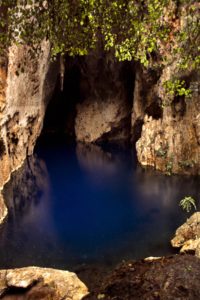
Where: Zimbabwe, Africa
Chinhoyi Caves in Zimbabwe are named for a Headman named Chinhoyi, who became a Mashona chief and also lent his name to the nearby town. The chief and his tribe used the caves to hide from raiding tribes, and until recently, visitors could see the remains of his grain bins in some of the cave's dry passages.
The cave's main feature is the Wonder Hole, which drops vertically for 150 feet (46 m) to the Sleeping Pool, where cave divers can descend. It's unclear where the water comes from, but it's blue, crystal-clear and maintains a year-round temperature of 72 F (22 C). Depth in the Sleeping pool varies from 262 to 299 feet (80 to 91 m), depending on rainfall. There are also several underwater passages leading from the pool, as well as other caves, some yet-to-be-explored.
Elephant's Cave
Where: Chania, Greece
The 30-foot-wide (9 m) entrance to Elephant's Cave is at a depth of between 25 and 39 feet (7.5 to 12 m). You'll swim into the cave for about 130 feet (40 m), passing red and white stalagmites and stalactites. The passageway ends in a large cavern, also filled with rock formations as well as the fossilized remains of an elephant, including teeth, vertebrae and a tusk. There are also numerous deer bones, belonging to both regular-sized and dwarf deer. The cave's maximum depth is 52 feet (16 m).
First Cathedral
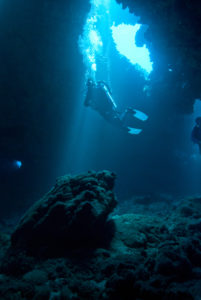
Where: Lanai, Hawaii
Through an archway, divers will find an underwater tunnel leading to a large cavern. Once a volcanic-lava tube, this cavern has a number of passages and tunnels to explore. In the cave you'll find the "Altar," an area where a section of the has roof collapsed, allowing sunrays to pierce the water and giving the Cathedral its name. Tiny holes in the back of the cave also allow sunlight to penetrate, creating a stained-glass effect. Divers will often see turtles, sharks and lobsters inside the cave. Exit through a small opening at the back of the cave, nicknamed 'torpedo' or 'shotgun tube' as the surge expels divers from the cave through this passage. The cave's maximum depth is 50 feet (15 m).
Jesser Canyon
Where: Sodwana Bay, South Africa
Diving Jesser Canyon is a highly technical experience, accessible only to those with proper training. The entrance to the canyon is at 312 feet (95 m), and it features a number of explorable caves. Although there are beautiful, volcanic-like rocks and an abundance of fish life and coral, the main attraction here is the presence of coelacanths, thought until recently to be extinct. Only a handful of people have ever dived Jesser Canyon and seen these elusive creatures.
Coelacanths were discovered here in 2000, and scientists consider them a "living fossil," as the only knowledge of other individuals in the same taxonomy comes from fossils. The maximum depth at Jesser Canyon is around 984 feet (300m); the coelacanths inhabit a cave at 380 feet (116 m).
The Shaft
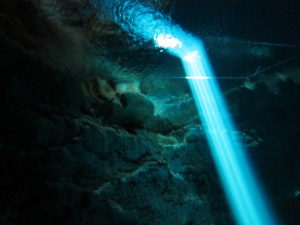
Where: South Australia
Divers enter the Shaft, a massive sinkhole in South Australia, through a tiny hole in the middle of a field. The Shaft, which plunges to 393 feet (120 m), is the country's deepest underwater cave. Divers enter after being lowered through a small manhole in the ground via a metal tripod located topside. Divers are suspended about 26 feet (8 m) above the surface and must drop to the surface from this height. The cave's entrance is about 65 feet (20 m) in diameter and the walls widen as you swim further on. Directly below the entrance is the Rockpile, the result of the property owner's attempt to fill the hole with rocky substrate without knowing how deep it was. Swimming out from the Rockpile, you'll find Sawtooth Rock, a natural feature at about 115 feet (35 m).
Nereo Cave (Grotta di Nereo)
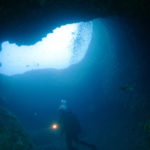
Where: Sardinia
Nero Cave is one of the biggest marine caves in the Mediterranean Sea, with numerous passages, air chambers and archways to explore. There are about 10 entrances to the cave, where you'll find archways and tunnels. Divers can see barracudas, red snappers, lobsters, moray eels and a variety of coral. The maximum depth is 115 feet (35 m).
Riwaka Caves
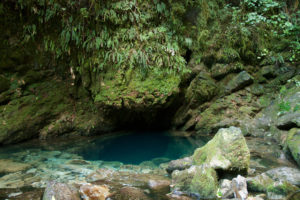
Where: Nelson, New Zealand
The entrance to Riwaka Caves is between 13 to 40 feet (4 and 12 m) deep and you can surface in two caverns after a short swim. In the further cavern, you can remove your gear and explore the cavern on foot. You'll find large boulders, stalactites and stalagmites and even a waterfall rushing over pink limestone. Maximum depth is unknown, but the average dive depth is between 30 to 40 feet (9 to 12 m).
Sra Keow Caves 1, 2 and 3
Where: Krabi/Ao Nang, Thailand
Divers enter Sra Keow caves via two small ponds. Sra Keow 1 and 2 are connected at depths of 262 feet and 656 feet (80 and 200 m), though most dives don't exceed 130 feet (40 m). Divers believe that Sra Keow 3 is connected to 1 and 2, but this underwater connection remains a mystery.
The post The World's 10 Top Cave Dives appeared first on Scuba Diver Life.
from Scuba Diver Life https://ift.tt/2LUp8sW
No comments:
Post a Comment